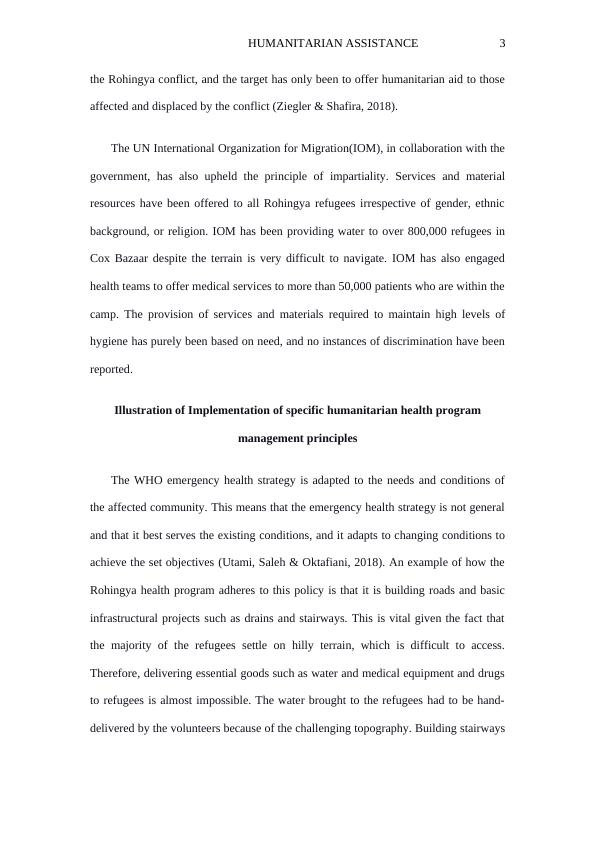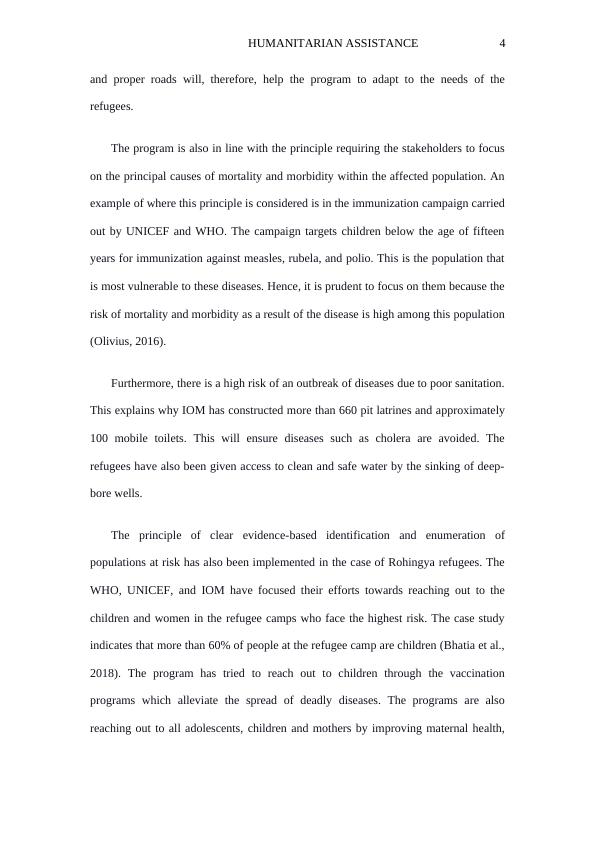Humanitarian Assistance and Health | Report
Summary of Dr Joanne Liu's remarks on the Rohingya crisis during a Pledging Conference in Geneva.
13 Pages3040 Words25 Views
Added on 2022-08-31
Humanitarian Assistance and Health | Report
Summary of Dr Joanne Liu's remarks on the Rohingya crisis during a Pledging Conference in Geneva.
Added on 2022-08-31
ShareRelated Documents
Running Head: HUMANITARIAN ASSISTANCE 1
Humanitarian Assistance and Health
Name of Student
Name of Professor
Institution Affiliation
Date
Humanitarian Assistance and Health
Name of Student
Name of Professor
Institution Affiliation
Date

HUMANITARIAN ASSISTANCE 2
Application of humanitarian principles in the case studies
One of the general humanitarian principles applied at the time of the
humanitarian crisis is the principle of humanity (Azad, Rifat, Manir & Biva, 2019).
This principle requires the prevention and alleviation of human suffering. This is
achieved by protecting and respecting the life, health, and dignity of the people
affected by the crisis. One of how the case study on the humanitarian crisis in
Bangladesh is applying this principle is through the immunization programs, which
are led by UNICEF in collaboration with WHO and the Bangladesh Ministry of
Health. This campaign is aimed at alleviating possible health crises through
immunization of more than 150,000 children against polio, measles, and rubella. A
disease like measles is very infectious, and hence an outbreak of measles in the
refugee camp can lead to disaster. The partners in the humanitarian crisis are also
helping improve maternal, new-born, and child health by improving water and
sanitation services. This significantly contributes to the improvement of hygiene
within the massive refugee camp and hence preventing the outbreak of diseases such
as cholera (Guglielmi et al., 2019). Additionally, the collaboration between WHO and
UNICEF has helped in the renovation of delivery and new-born units within the
camp. Disease surveillance has also been improved, and dissemination of early
warning and health-related information has also been enhanced to prevent a potential
outbreak of diseases which would be difficult to manage.
The principle of neutrality has also been applied in the three case studies. The aid
provided by the UN organizations only targets refugees who have been affected by
the conflict in Myanmar. The organizations have not supported any of the parties to
Application of humanitarian principles in the case studies
One of the general humanitarian principles applied at the time of the
humanitarian crisis is the principle of humanity (Azad, Rifat, Manir & Biva, 2019).
This principle requires the prevention and alleviation of human suffering. This is
achieved by protecting and respecting the life, health, and dignity of the people
affected by the crisis. One of how the case study on the humanitarian crisis in
Bangladesh is applying this principle is through the immunization programs, which
are led by UNICEF in collaboration with WHO and the Bangladesh Ministry of
Health. This campaign is aimed at alleviating possible health crises through
immunization of more than 150,000 children against polio, measles, and rubella. A
disease like measles is very infectious, and hence an outbreak of measles in the
refugee camp can lead to disaster. The partners in the humanitarian crisis are also
helping improve maternal, new-born, and child health by improving water and
sanitation services. This significantly contributes to the improvement of hygiene
within the massive refugee camp and hence preventing the outbreak of diseases such
as cholera (Guglielmi et al., 2019). Additionally, the collaboration between WHO and
UNICEF has helped in the renovation of delivery and new-born units within the
camp. Disease surveillance has also been improved, and dissemination of early
warning and health-related information has also been enhanced to prevent a potential
outbreak of diseases which would be difficult to manage.
The principle of neutrality has also been applied in the three case studies. The aid
provided by the UN organizations only targets refugees who have been affected by
the conflict in Myanmar. The organizations have not supported any of the parties to

HUMANITARIAN ASSISTANCE 3
the Rohingya conflict, and the target has only been to offer humanitarian aid to those
affected and displaced by the conflict (Ziegler & Shafira, 2018).
The UN International Organization for Migration(IOM), in collaboration with the
government, has also upheld the principle of impartiality. Services and material
resources have been offered to all Rohingya refugees irrespective of gender, ethnic
background, or religion. IOM has been providing water to over 800,000 refugees in
Cox Bazaar despite the terrain is very difficult to navigate. IOM has also engaged
health teams to offer medical services to more than 50,000 patients who are within the
camp. The provision of services and materials required to maintain high levels of
hygiene has purely been based on need, and no instances of discrimination have been
reported.
Illustration of Implementation of specific humanitarian health program
management principles
The WHO emergency health strategy is adapted to the needs and conditions of
the affected community. This means that the emergency health strategy is not general
and that it best serves the existing conditions, and it adapts to changing conditions to
achieve the set objectives (Utami, Saleh & Oktafiani, 2018). An example of how the
Rohingya health program adheres to this policy is that it is building roads and basic
infrastructural projects such as drains and stairways. This is vital given the fact that
the majority of the refugees settle on hilly terrain, which is difficult to access.
Therefore, delivering essential goods such as water and medical equipment and drugs
to refugees is almost impossible. The water brought to the refugees had to be hand-
delivered by the volunteers because of the challenging topography. Building stairways
the Rohingya conflict, and the target has only been to offer humanitarian aid to those
affected and displaced by the conflict (Ziegler & Shafira, 2018).
The UN International Organization for Migration(IOM), in collaboration with the
government, has also upheld the principle of impartiality. Services and material
resources have been offered to all Rohingya refugees irrespective of gender, ethnic
background, or religion. IOM has been providing water to over 800,000 refugees in
Cox Bazaar despite the terrain is very difficult to navigate. IOM has also engaged
health teams to offer medical services to more than 50,000 patients who are within the
camp. The provision of services and materials required to maintain high levels of
hygiene has purely been based on need, and no instances of discrimination have been
reported.
Illustration of Implementation of specific humanitarian health program
management principles
The WHO emergency health strategy is adapted to the needs and conditions of
the affected community. This means that the emergency health strategy is not general
and that it best serves the existing conditions, and it adapts to changing conditions to
achieve the set objectives (Utami, Saleh & Oktafiani, 2018). An example of how the
Rohingya health program adheres to this policy is that it is building roads and basic
infrastructural projects such as drains and stairways. This is vital given the fact that
the majority of the refugees settle on hilly terrain, which is difficult to access.
Therefore, delivering essential goods such as water and medical equipment and drugs
to refugees is almost impossible. The water brought to the refugees had to be hand-
delivered by the volunteers because of the challenging topography. Building stairways

HUMANITARIAN ASSISTANCE 4
and proper roads will, therefore, help the program to adapt to the needs of the
refugees.
The program is also in line with the principle requiring the stakeholders to focus
on the principal causes of mortality and morbidity within the affected population. An
example of where this principle is considered is in the immunization campaign carried
out by UNICEF and WHO. The campaign targets children below the age of fifteen
years for immunization against measles, rubela, and polio. This is the population that
is most vulnerable to these diseases. Hence, it is prudent to focus on them because the
risk of mortality and morbidity as a result of the disease is high among this population
(Olivius, 2016).
Furthermore, there is a high risk of an outbreak of diseases due to poor sanitation.
This explains why IOM has constructed more than 660 pit latrines and approximately
100 mobile toilets. This will ensure diseases such as cholera are avoided. The
refugees have also been given access to clean and safe water by the sinking of deep-
bore wells.
The principle of clear evidence-based identification and enumeration of
populations at risk has also been implemented in the case of Rohingya refugees. The
WHO, UNICEF, and IOM have focused their efforts towards reaching out to the
children and women in the refugee camps who face the highest risk. The case study
indicates that more than 60% of people at the refugee camp are children (Bhatia et al.,
2018). The program has tried to reach out to children through the vaccination
programs which alleviate the spread of deadly diseases. The programs are also
reaching out to all adolescents, children and mothers by improving maternal health,
and proper roads will, therefore, help the program to adapt to the needs of the
refugees.
The program is also in line with the principle requiring the stakeholders to focus
on the principal causes of mortality and morbidity within the affected population. An
example of where this principle is considered is in the immunization campaign carried
out by UNICEF and WHO. The campaign targets children below the age of fifteen
years for immunization against measles, rubela, and polio. This is the population that
is most vulnerable to these diseases. Hence, it is prudent to focus on them because the
risk of mortality and morbidity as a result of the disease is high among this population
(Olivius, 2016).
Furthermore, there is a high risk of an outbreak of diseases due to poor sanitation.
This explains why IOM has constructed more than 660 pit latrines and approximately
100 mobile toilets. This will ensure diseases such as cholera are avoided. The
refugees have also been given access to clean and safe water by the sinking of deep-
bore wells.
The principle of clear evidence-based identification and enumeration of
populations at risk has also been implemented in the case of Rohingya refugees. The
WHO, UNICEF, and IOM have focused their efforts towards reaching out to the
children and women in the refugee camps who face the highest risk. The case study
indicates that more than 60% of people at the refugee camp are children (Bhatia et al.,
2018). The program has tried to reach out to children through the vaccination
programs which alleviate the spread of deadly diseases. The programs are also
reaching out to all adolescents, children and mothers by improving maternal health,

End of preview
Want to access all the pages? Upload your documents or become a member.
Related Documents
Humanitarian Assistance Case Study 2022lg...
|9
|2443
|17
Humanitarian Assistance and Healthlg...
|12
|3035
|83
UN Procurement and Logistics in Humanitarian Crisislg...
|23
|7357
|18
PUBH640 - Global Health and Sustainable Developmentlg...
|7
|1572
|203
Communicable Disease Control Plan for Boarding Schoolslg...
|16
|3976
|365
Hospital policy on influenza immunizationlg...
|8
|2016
|50
